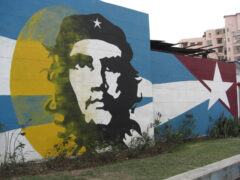Is it safe to travel to Colombia?

We look into the facts behind Colombia’s notorious reputation to reveal an incredibly welcoming country, which deserves to be seen in a new light.
Colombia’s reputation precedes it: violence, drug cartels, civil war, revolutionary guerrillas, kidnappings, corruption… For the past 52 years this cocktail of chaos has captured the world’s imagination and with such close attention being paid to the country’s flaws, criminality, atrocities even, it is unsurprising that tourism here has never really taken hold. The global press has, over the years, painted a portrait of Colombia that has stuck in the minds of many: mention to someone that you are planning on travelling here and you might see a raised eyebrow and hear the following question: “Colombia? But isn’t it dangerous?”
This is a difficult question to answer. Still recovering from a traumatic past, struggling with the problems faced at present, and contemplating the uncertainties of the future, Colombia is a complex place. There remain parts of the country where travel is advised against (mainly rural areas where coca production remains prevalent) – however, slowly but surely, slices of green are pushing back the swathes of yellow on the UK Foreign and Commonwealth Office (FCO)travel advisory map.
Progress is being made and Colombia is opening up to tourism. Take, for instance, the archaeological site of San Agustín: for years, this UNESCO-listed site was off-limits due to guerrilla activity in the surrounding area. Today, improved security means it is now deemed safe by the FCO and visitors can safely discover the beauty and the history of the region.
Reduced guerrilla activity is partly down to four years of negotiations between the Colombian government and the left-wing rebel group, FARC (Revolutionary Armed Forces of Colombia). The FARC have upheld a unilateral ceasefire since July 2015 and in August 2016 the Colombian government introduced a bilateral ceasefire. What’s more, in November 2016 the incumbent President, Juan Manuel Santos, signed a peace deal with the FARC to end the internal armed conflict, which has now been ratified. It has been a highly emotional, often fraught, process with some major setbacks, but a deal has been struck and President Juan Manuel Santos was even awarded the Nobel Peace Prize for his “resolute efforts” to end the conflict.
Tourism in Colombia has grown every year for the last decade, with foreign visitors increasing by 16% from 2014-15, and high-profile events such as the peace accord are helping to firmly place the country on people’s travel radar. Improved safety, more generally, has also played a big part in this relative boom: most people travel to the country without incident and return home raving about the friendly, helpful people, the beautiful landscapes and the wonderful experiences they had. Word-of-mouth being as powerful as it is, it’s hoped that more and more people will be encouraged to cast aside their preconceptions about Colombia and explore it for themselves.
In the end, your safety when travelling usually comes down to common sense. What’s true in Rio, Cape Town, Delhi, is true in Bogotá, Medellín and Cartagena: be vigilant at night; don’t flash your valuables; don’t blindly trust a stranger; use your better judgement. Well-travelled routes around Bogotá, the coffee region, Cartagena and the Caribbean coast, for example, will feel no less safe than other well-visited parts of Latin America and when you travel with Journey Latin America our partners throughout Colombia will advise you on safety and security – after all, local knowledge is invaluable. Even over here in London we strive to stay up-to-date with what’s going on in Colombia so that we can help inform your travel as much as possible.
So, is it safe to travel to Colombia? My answer is “Yes!” – go, have fun, fall in love with a truly magical country, tell your friends and family about it, and become one of the people helping to brush away those outdated ideas about travel in Colombia.
Browse our Colombia holidays.
Tailor-made holidays
Flexible, custom-made holidays to Latin America created to match your exact requirements: our tailor-made itineraries are as unique as the clients for whom they are designed.
Design my tripPapagaio
Your edit for Latin American inspiration
Our exciting range of articles on Latin America explore everything from iconic destinations and lesser-known cultural gems to delicious traditional recipes. You’ll also find exclusive travel tips, first-hand client reviews and the chance to get your personal questions answered by our travel experts.
View Extraordinary Inspiration






































